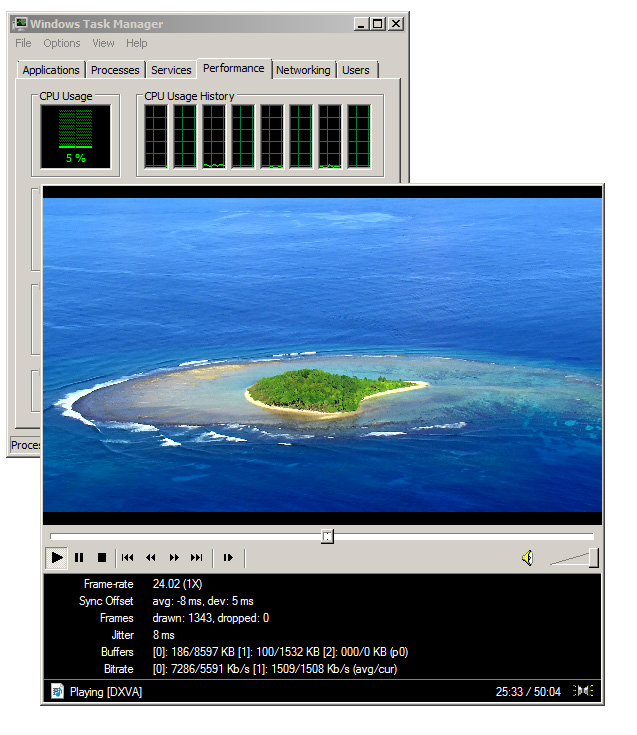Universal Video Decoder 3.0
Universal Video Decoder 3.0
UVD, short for Universal Video Decoder, synonym to the video processors embedded into the GPU of the graphics card. With proper 3rd party software like WinDVD or PowerDVD or the free Media Player Classic you can enable support for UVD which provides hardware acceleration for media content like MPEG2, H.264 and VC-1 high definition video formats used by Blu-ray.
In short, this feature allows the video processor in the GPU to apply hardware acceleration and video processing functions while keeping power consumption & CPU utilization low on your movies and video's.
That means a low CPU utilization whilst scoring maximum image quality. Over the years this engine has advanced and it's really not massively different opposed to the older UVD engines but we do see some new tweaks. Dual stream decoding was already introduced in UVD2. So for example, if you playback a Blu-ray movie and simultaneously want to see a director's commentary (guided by video) you can now look at both the movie and in a smaller screen see the additional content (like picture-in-picture). Obviously this is Blu-ray 2.0 compatibility here, and the additional content is an actual feature of the movie. But definitely fun to see.
Video acceleration post-processed by your GPU
The x.264 format is often synonym with Matroska MKV, a media file container which often embeds that x.264 content, a much admired container format for media files. Especially the 1920x1080P movies often have some form of h.264 encoding dropped within the x.264 format. As a result, you'll need a very beefy PC with powerful processor to be able to playback such movies, error free without frames dropping and nasty stutters as PowerDVD or other PureVideo HD supporting software by itself will not support it.
Any popular file-format (XVID/DIVX/MPEG2/MPEG4/h.264/MKV/VC1/AVC) movie can be played on this little piece of software, without the need to install codecs and filters, and where it can, it will DXVA enable the playback. DXVA is short for Direct X Video Acceleration, and as you can tell from those four words alone, it'll try wherever it can to accelerate content over the GPU, offloading the CPU. Which is what we are after.
There's more to this software though:
- A much missed feature with NVIDIA's PureVideo and ATI's UVD is the lack of a very simple function, yet massively important, pixel (image) sharpening.
If you watch a movie on a regular monitor, Purevideo playback is brilliant. But if you display the movie on a larger HD TV, you'll quickly wish you could enable little extra's like sharpening. I remember GeForce series 7 having this native supported from within the Forceware drivers. After GeForce series 8 was released, that feature was stripped away, and to date it has to be the most missed HTPC feature ever.
Media Player Classic has yet another advantage, as not only it tries to enable DXVA where possible through the video processor, it also can utilize the shader processors of your graphics cards and use it to post-process content. A lot of shaders (small pieces of pixel shader code) can be executed within the GPU to enhance the image quality. MCP has this feature built in, you can even select several shaders like image sharpening, de-interlacing, combine them and thus run multiple shaders (enhancement) simultaneously. Fantastic features for high quality content playback.
Here you see MPC HT edition accelerating an x.264 version of a movie @ 1080P. Mind you that the one spike in CPU cycles is me starting up the actual capture software.
The Radeon 6000 series will completely accelerate (DXVA) this movie without any issues. Complex Image sharpening is handled by the shaders processors and we have PC 0-255 Color profile activated over the shaders as well to get nicer black levels. Even if we expand this window to a resolution of 2560x1600 the CPU load will remain low and the graphics card manages that resolution fine.
Resource:
-
Download Media Player Classic HC (free public domain software)
The GPU is doing all the work as you can see, the h.264 content within the x.264 file container is not even a slight bit accelerated over the CPU. Read more about this feature right here in this article.
 BBC Earth 1080P runs optimized and post processed over the Radeon HD 6000 series, including quality optimizations as image sharpening. That 5% CPU load is me starting up the screen grab software and actual screen grab btw.
BBC Earth 1080P runs optimized and post processed over the Radeon HD 6000 series, including quality optimizations as image sharpening. That 5% CPU load is me starting up the screen grab software and actual screen grab btw.
